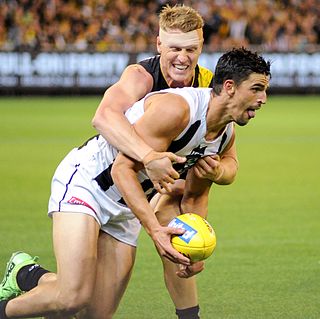
Most forms of football have a move known as a tackle. The primary purposes of tackling are to dispossess an opponent of the ball, to stop the player from gaining ground towards goal or to stop them from carrying out what they intend.

In American football, the Holy Roller was a controversial game-winning play by the Oakland Raiders against the San Diego Chargers on September 10, 1978, at San Diego Stadium in San Diego, California. It was officially ruled as a forward fumble by Raiders quarterback Ken Stabler that was recovered by his teammate, tight end Dave Casper, in the end zone for a touchdown, giving Oakland the 21–20 win. However, there have been differing interpretations of how this play should have actually been ruled, and it has remained a controversial play for fans of both teams involved. The NFL amended its rules after the 1978 season to prevent a recurrence of the play. Chargers fans refer to the play as the Immaculate Deception.
In American and Canadian football, pass interference (PI) is a foul that occurs when a player interferes with an eligible receiver's ability to make a fair attempt to catch a forward pass. Pass interference may include tripping, pushing, pulling, or cutting in front of the receiver, covering the receiver's face, or pulling on the receiver's hands or arms. It does not include catching or batting the ball before it reaches the receiver. Once the ball touches any defensive player or eligible offensive receiver, the above rules no longer apply and the defender may tackle the receiver or attempt to prevent them from gaining control of the ball. Once a forward pass is in the air it is a loose ball and thus any eligible receiver – all defensive players are eligible receivers – may try to catch it. When a defensive player catches a forward pass it is an interception and their team gains possession of the ball. Some actions that are defined as pass interference may be overlooked if the defender is attempting to catch or bat the ball rather than focusing on the receiver.
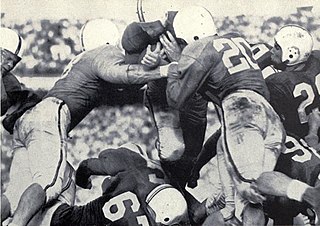
A quarterback sneak is a play in gridiron football in which the quarterback, upon taking the center snap, dives ahead while the offensive line surges forward. It is usually only used in very short yardage situations.

Gameplay in American football consists of a series of downs, individual plays of short duration, outside of which the ball is or is not in play. These can be plays from scrimmage – passes, runs, punts or field goal attempts – or free kicks such as kickoffs and fair catch kicks. Substitutions can be made between downs, which allows for a great deal of specialization as coaches choose the players best suited for each particular situation. During a play, each team should have no more than 11 players on the field, and each of them has specific tasks assigned for that specific play.
The 2005 NFL season was the 86th regular season of the National Football League (NFL).
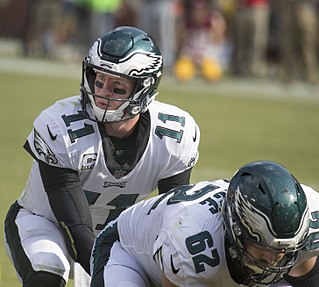
Center or centre (C) is a position in American football. The center is the innermost lineman of the offensive line on a football team's offense. The center is also the player who passes the ball between his legs to the quarterback at the start of each play.
The 1976 NFL season was the 57th regular season of the National Football League. The league expanded to 28 teams with the addition of Seattle Seahawks and Tampa Bay Buccaneers. This fulfilled one of the conditions agreed to in 1966 for the 1970 AFL–NFL merger, which called for the league to expand to 28 teams by 1970 or soon thereafter.

The horse-collar tackle is a gridiron football maneuver in which a defender tackles another player by grabbing the back collar or the back-inside of an opponent's shoulder pads and pulling the ball carrier directly downward violently in order to pull his feet from underneath him. The technique is most closely associated with Pro Bowl safety Roy Williams.
The 1940 NFL season was the 21st regular season of the National Football League. The season ended when the Chicago Bears defeated the Washington Redskins in the NFL Championship Game by 73–0; this result still stands as the most one-sided victory in NFL history as of the 2023 season.
The 2005 USC vs. Notre Dame football game was a regular season game that took place on October 15, 2005 at Notre Dame Stadium. The game between perennial rivals USC and Notre Dame was played for the Jeweled Shillelagh. The game was preceded by much pre-game hype, including a visit by College GameDay. In what became known as the "Bush Push", the game ended with quarterback Matt Leinart being pushed by running back Reggie Bush into the end zone for the winning touchdown. His push was illegal assistance under the laws of the game but it was not called a foul by the officials.

A comparison of American football and rugby union is possible because of the games' shared origins, despite their dissimilarities.
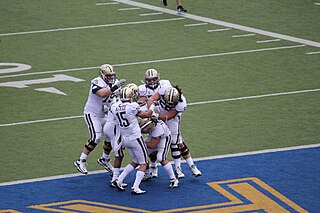
In gridiron football, touchdown celebrations are sometimes performed after the scoring of a touchdown. Individual celebrations have become increasingly complex over time, from simple "spiking" of the football in decades past to the elaborately choreographed displays of the current era.
The following terms are used in American football, both conventional and indoor. Some of these terms are also in use in Canadian football; for a list of terms unique to that code, see Glossary of Canadian football.
A penalty in rugby union is the main disciplinary sanction available to the referee to penalise a team who commit deliberate infringements. The team who did not commit the infringement are given possession of the ball and they may either kick it towards touch, attempt a place kick at goal, or tap the ball with their foot and run. It is also sometimes used as shorthand for penalty goal.

In gridiron football, a penalty is a sanction assessed against a team for a violation of the rules, called a foul. Officials initially signal penalties by tossing a bright yellow colored penalty flag onto the field toward or at the spot of a foul.
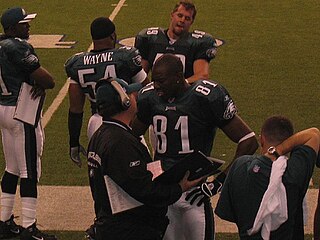
In sports, out of bounds refers to being outside the playing boundaries of the field. The legality of going out of bounds, and the ease of prevention, vary by sport. Sports that use this term include American football, Canadian football, field lacrosse, basketball, rugby union, rugby league, and association football.

In gridiron football, a punt is a kick performed by dropping the ball from the hands and then kicking the ball before it hits the ground. The most common use of this tactic is to punt the ball downfield to the opposing team, usually on the final down, with the hope of giving the receiving team a field position that is more advantageous to the kicking team when possession changes. The result of a typical punt, barring any penalties or extraordinary circumstances, is a first down for the receiving team. A punt is not to be confused with a drop kick, a kick after the ball hits the ground, now rare in both American and Canadian football.
The Packers sweep, also known as the Lombardi sweep, is an American football play popularized by Green Bay Packers coach Vince Lombardi. The Packers sweep is based on the sweep, a football play that involves a back taking a handoff and running parallel to the line of scrimmage before turning upfield behind lead blockers. The play became noteworthy due to its extensive use by the Packers in the 1960s, when the team won five National Football League (NFL) Championships, as well as the first two Super Bowls. Lombardi used the play as the foundation on which the rest of the team's offensive game plan was built. The dominance of the play, as well as the sustained success of Lombardi's teams in the 1960s, solidified the Packers sweep's reputation as one of the most famous football plays in history.
Rodney Parker is an American former gridiron football wide receiver who played six seasons professionally. He played college football at Tennessee State and was a sixth round NFL draft pick of the Atlanta Falcons in 1978. After being released by them in training camp, Parker signed in the Canadian Football League (CFL) with the Saskatchewan Roughriders, with whom he would play until being released in 1979. In the 1980 season, Parker returned to the National Football League (NFL) by signing with the Philadelphia Eagles. After two seasons with them, Parker played two years in the United States Football League (USFL) with the Philadelphia Stars and San Antonio Gunslingers.











